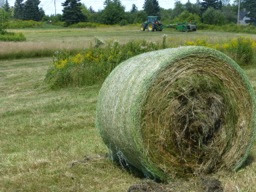The first swing I remember was hung from a huge maple tree in our yard. My Dad would push me up so high I could touch another limb with my feet. I could never achieve that height by pumping. I could twist the ropes so when un-twisting it spun so fast it made me crazy dizzy and I couldn't stand. Still a little that way, And I don't have a swing!
My dog, Skippy, would try to grab my feet as I spun around, and once did he hold on to spin with me. I laughed so hard tears were in my eyes. Now you have to remember this was when I was 5 or 6 and during the depression. This was my entertainment.
During WW2, I was 8 or 9 when my Dad set up a wall tent under the biggest maple tree in the yard. It was shaded and cool all day long. In the fall these maple trees provided me with huge leaf mountains that I could jump into for hours.
Skippy, my dog, would become so lost under them, it would take all I could do to find him. He loved it, this was his entertainment too.
Up on the hill behind the old Railroad Station, there was a grove of white birch trees, Oh how I loved to swing on them.
Robert Frost seemed to have it right; (from "Birches"
''I don't know where it's likely to go better.
I'd like to go by climbing a birch tree,
and climb black branches up a snow-white trunk
toward heaven, till the tree could bear no more,
but dipped its top and set me down again.
That would be good both going and coming back.
One could do worse than be a swinger of birches''.
We had three apple trees also, but they just didn't provide the same climbing and swinging as the maples and birches.
The maples were big but, the elms across the street were much taller than any other tree around. They rose into the sky like sky scrapers. They were nearly impossible to climb -- the limbs were too far from the ground to reach -- and if you could, there were no low branches to grab onto.
 |
| There were four stately elms and one runt on the Seaview Railroad Station property. The four on Station Street were very large and healthy; the one near the tracks was the runt, and dying. c.1943. |
Mr. and Mrs. Baltimore Oriole made their home in a grey, neatly-woven nest, hanging from a limb that reached out over Station Street. Mr. Oriole sang his beautiful song to us for many summers. I remember one summer, the tree was sick, the branch that supported the orioles' nest broke and crashed onto Station Street. Fortunately, the oriole family had raised their youngsters and had left.
Sadly the Great Elms died and the orioles never returned. (c.1955)
These Elms were at 272 Summer Street. (''The Little Green Light Tea Room'' c. 1910)
 |
| Today, this lovely Cape Cod home appears to be doomed. |
 |
| Elms along Elm Street on the left and birches on the right. Looking E. from Summer Street, c.1910 |
 |
| Elms along Prospect and Summer Streets, looking E. c. 1915 |
 |
| Elms along Prospect Street, looking E. |
 |
| Elms lining the four corners of Marshfield Hills and every street in the hills. |
 |
| More, stately elms on Patrick's Lane, once Bridge Street/Main Street. |
 |
| The lane to Daniel Webster's Estate. |
These are just a few of the Stately American Elms I remember in town.
How sad I was seeing our five elms fighting to live, but slowly succumbing to the Dutch Elm disease.
"Trees love to
toss and sway.
They make
such happy
noises"
- Emily Carr
by Ray Freden
Seaview/Marshfield, 70 years
Down East Maine, 11 yrs.

































